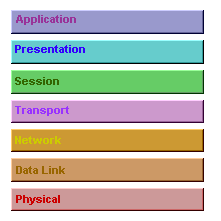Transfer syntax
PRESENTATION LATER SERVICES
PRESENTATION LATER STANDARDS
X.409
BNF
Standard representation
OSI Security
PRESENTATION LAYER - CRYPTION
PRESENTATION LAYER - ENCRYPTION
Services provided to the application layer
Summary of presentation layer service elements
1.0 - Introduction
The presentation layer provides for the representation of information:
The representation of data to be transferred between application - entities.
The representation of the data structure which application-entities refer
to in their communication, along with the representations of the set of actions
which may be performed on this data structure.
The presentation layer is concerned only with:
SYNTAX - ie. the representation of the data.
and not with its:
SEMANTICS - if their meaning to the application layer which is known only
by the application-entities.
Although it might seem obvious that different syntaxes were needed, depending on the form of data being transferred (files, jobs, terminal streams, etc.), this was not the case and ISO worked on the development of a common protocol which can cope with any transfer syntax (analogous to the concept of a metalanguage in compiler construction).
Transfer syntax
The syntax used for the transfer of data is known as the "transfer syntax"
and, although early work on the transfer of data between dissimilar systems
tried to define a "network syntax" which the systems had to translate
into and out of, there is no need for this and the transfer syntax may be identical
to the syntax used in the source or destination machine or both.
Source Syntax
__________________________ __________________________
Name ....................
Name ....................
Address .................
Address .................
SYSTEM
__________________________ ____________________________
Ways to determine what transfer syntax:
Syntax is predetermined (ie. when A communicates with B it will always use a certain syntax).
A set of transfer syntaxes which both systems "know about" and they choose one (referred to by name). These syntaxes could be private.
To send a description of the syntax to be used.
PRESENTATION LATER SERVICES
Services provided by the presentation layer
- Session establishment request
- Data transfer
- Negotiation and renegotiation of syntax
- Transformations of syntax including data transformation, formatting and special-purpose transformations (for example, compression)
- Session termination request
A number of the services provided by the presentation layer (eg. synchronisation)
map directly onto the corresponding service in the next lower layer-session.
One particular function of the presentation later is the ability to change the transfer syntax during a transfer, using the P-context-define and P-context-select primitives.
PRESENTATION LATER STANDARDS
The presentation layer requires a kind of metalanguage an example of a metalanguage
is BNF.
It was decided to define a rather more flexible metalanguage and this has
become known as ASN.1 ("abstract syntax notation one"). This evolved
from the xerox "courier" specification (part of XNS).
CCITT has a single standard X.409 - presentation transfer syntax and notation. The X400 series is MHS - message handling systems and is likely to be renumbered in the X.200 series.
DIS 8824 - specifidcation of abstract syntax notation one
DIS 8825 - specification of basic encoding rules for abstract syntax notation
one.
code conv table
X409 is based on BNF
OSI Security
It is not clear into what layer of the OSI model
encrypton should be done, if
it is done below level 3 then in order for intermediate nodes to understand
the headers and trailers, the entire message must be decrypted at every intermediate
node, this could cause security risks. If encrypton
is done only at the highest layer then routing and other information
could be gleaned from message headers. Therefore where maximum security is required
encrypton must be done in several
layers.
Although "security" often implies encrypton (or a related technique) for making the text of a message unreadable, there are many more services required to provide the necessary degree of security in a network
environment.
One such service is "traffic flow security". This means that an
unauthorised user cannot obtain information
by analysis of the traffic flows.
Another service is authentication. There are a number
of varieties of this but they have a common purpose, namely to ensure that messages
are received from the correct source and not an unauthorised source. Two related
services ("non-repudiation") ensure that a sender or receiver of data
cannot deny having sent or received the data (in the case of a receiver, this
is analogous to "recorded delivery" in the mail services.
The OSI security Addendum postulates the existance
of a Security Management Information Base (SMIB). This specifies the functions
required by and from each layer and thus ensures that security is maintained.
Standards
IS 7498 - Security appendix to the reference model
DIS 8227 - DES Data encipherment: specification of algorithm DEA1
DIS 8372 - DES Modes of operation for a 64-bit block cipher algorithm
ANSI X3.105 - Data link Encryption.
PRESENTATION LAYER - CRYPTION
Services provided to the application layer
1 - Transformation of syntax;
2 - Selection of syntax
Three syntactic versions,
1 - syntax used by the originating application
2 - syntax used by the receiving application
3 - syntax used between presentation-entities
Examples
1 - encription
2 - compression
3 - syntax convertion
4 - graphics
Functions within the Presentation Layer
1 - session establishment request;
2 - data transfer;
3 - negotiation and renegotiation of syntax;
4 - transformation of syntax including data transformation and formatting
and special purpose transformations (e.g. compression)
5 - Session termination request.
Added Value Provided by the Presentation
Layer
- Definitions of contexts, which are sets of catogories of information, each category being a particular syntax.
- Transformation of syntax within each context.
- Selection of a particular context.
Summary of presentation layer service elements
| Capability | Service element | Type |
| Establishment | P-CONNECT | Confirmed |
| Termination | P-RELEASE | Confirmed |
| P-U-ABORT | Non-confirmed | |
| P-P-ABORT | provider initiated | |
| Context | P-CONTEXT-DEFINE | confirmed |
| P-CONTEXT-SELECT | confirmed | |
| P-TRANSFER | unconfirmed | |
| P-PURGE | unconfirmed | |
| Interruption | P-SUSPEND | confirmed |
| P-RESUME | confirmed | |
| Status | P-EXCEPTION-REPORT | provider initiated |
| Access | P-REQUEST-TOKEN | |
| P-PASS-TOKEN | ||
| P-MARK | ||
| P-SYNCHRONIZE | ||
| P-RELEASE-MARK |


